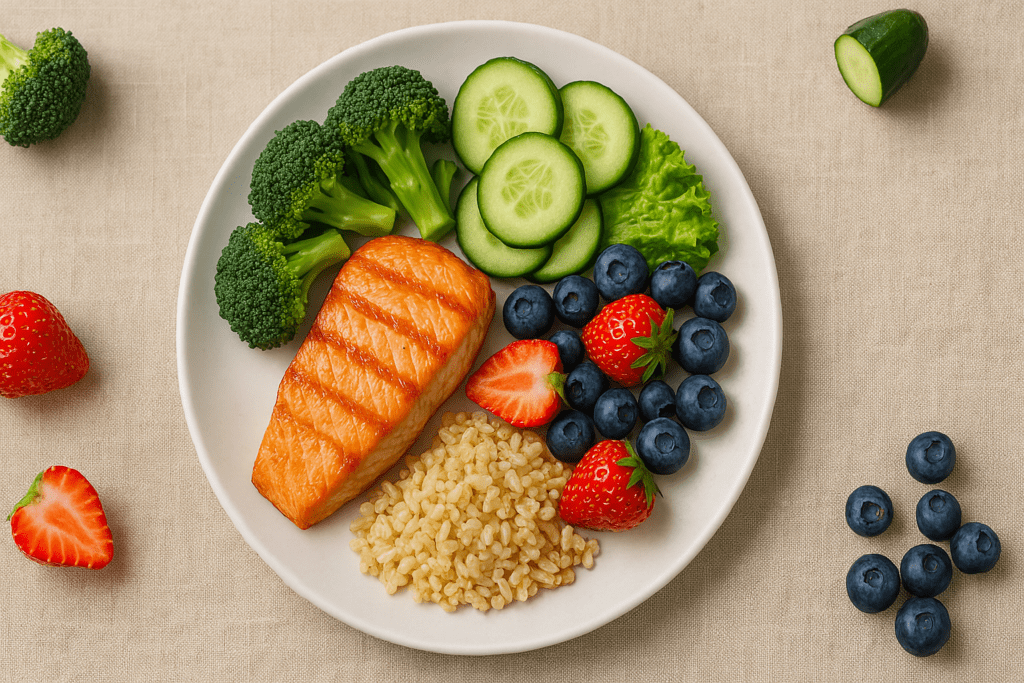In today’s fast-paced world, understanding how to nourish the body through smart, balanced eating has never been more important. As individuals seek to enhance their well-being through dietary choices, the concept of a balanced diet healthy plate emerges as a powerful, evidence-based guide. Drawing from the principles outlined in the MyPlate model, this comprehensive nutrition guide explores how everyday eating habits can align with long-term health goals. The balanced diet healthy plate serves as more than a visual cue; it is a roadmap for sustaining vitality, preventing chronic disease, and promoting mindful food decisions through knowledge of the food groups plate and how they interact within our bodies.
You may also like: Smart Healthy Eating Tips for Busy Professionals: How to Stay Nourished When You’re Always on the Go
At the core of this framework lies the understanding of what are the 5 groups of MyPlate: fruits, vegetables, grains, protein, and dairy. These food categories provide the essential nutrients necessary for physical and mental function, yet many individuals struggle to implement these guidelines effectively. Through an exploration of MyPlate food categories and their scientific underpinnings, this article will offer practical insights into using this model in daily life. We will also discuss how traditional models, such as the healthy food pyramid or nutrition food chart, compare and complement this newer approach. Whether you are a student seeking nutritional clarity or a health-conscious adult refining your habits, this guide bridges information with action, empowering you to personalize your plate with purpose.
A Modern Take on Nutrition: From the Healthy Food Pyramid to MyPlate
Before the introduction of MyPlate, the healthy food pyramid served as the primary educational tool for nutrition in the United States. Developed in the early 1990s, the pyramid emphasized hierarchical food groups with a broad base of grains and ascending layers of fruits, vegetables, proteins, dairy, and limited fats and sugars. While it provided a structured view of healthy eating, the pyramid’s vertical format and lack of meal-time context eventually led to confusion among consumers. Over time, health professionals recognized that a more intuitive, meal-based visual aid was needed.
Enter MyPlate—a dynamic update grounded in current nutrition science and behavioral psychology. MyPlate reimagines the food groups plate into a circular icon that mirrors how people typically organize their meals. This simple yet profound design illustrates the ideal proportions of each food group on a single plate, making it easier to visualize balance in real time. Unlike the static, top-down interpretation of the healthy food pyramid, MyPlate encourages interactive engagement with food choices, supporting mindful decisions meal by meal.
The MyPlate approach aligns well with the core values of the nutrition food chart while offering more accessible implementation. Rather than simply focusing on quantity or hierarchy, MyPlate emphasizes the diversity of nutrients within each group. For instance, not all grains are equal; whole grains are encouraged over refined options due to their fiber content and glycemic control benefits. Likewise, within the protein group, lean meats, plant-based sources, and seafood are promoted for their cardiovascular and metabolic advantages. In essence, MyPlate evolves beyond the structure of the healthy food pyramid to offer an updated lens through which we can understand food selection and nutritional quality.

Breaking Down the Food Groups Plate: The Foundation of Nutritional Balance
To fully benefit from the MyPlate model, one must understand the components of the food groups plate in depth. Each of the five categories contributes a unique array of nutrients that fulfill essential physiological roles. Fruits and vegetables, occupying half the plate in the MyPlate icon, supply dietary fiber, antioxidants, vitamins, and minerals. Their placement reflects the growing body of research supporting plant-based eating for disease prevention and immune support.
Grains, which constitute about one-quarter of the plate, are rich in carbohydrates—the body’s primary energy source. Choosing whole grains over refined grains ensures a slower digestion rate, reducing spikes in blood sugar and enhancing satiety. Proteins also make up one-quarter of the plate and should come from a variety of lean sources. Eggs, beans, poultry, tofu, and nuts offer amino acids necessary for muscle repair, hormone production, and immune resilience.
Dairy, often represented as a small cup or side serving in the MyPlate model, provides calcium, vitamin D, and other bone-strengthening nutrients. Importantly, the MyPlate guidelines emphasize the role of low-fat or non-fat dairy alternatives, accommodating lactose intolerance and plant-based preferences. Together, these MyPlate food categories form a holistic framework that encourages moderation, variety, and nutrient density.
The Practical Application of the Nutrition Food Chart in Daily Life
Despite having access to structured models like MyPlate and the nutrition food chart, many people struggle with real-world application. One effective strategy involves meal planning that mirrors the MyPlate proportions across breakfast, lunch, and dinner. For example, a balanced breakfast could feature oatmeal (whole grain), Greek yogurt (dairy), sliced banana (fruit), and a sprinkle of nuts (protein). Lunch might consist of a salad with leafy greens (vegetables), grilled chicken (protein), brown rice (grain), and apple slices on the side (fruit).
Utilizing the nutrition food chart in conjunction with MyPlate enhances awareness of portion control and food diversity. Individuals can also use the chart to identify nutrient gaps and refine their shopping lists. If someone notices a consistent lack of leafy greens or legumes in their diet, they can take action by intentionally incorporating spinach or lentils into future meals. These tools are most effective when used not as rigid formulas, but as flexible guides that evolve with a person’s needs, preferences, and lifestyle.
Furthermore, digital tools and apps can bridge the gap between theory and practice. Many nutrition tracking platforms now include MyPlate-based visuals that adapt to user input and provide personalized feedback. This intersection of technology and nutrition education holds promise for improving dietary habits across populations. By demystifying the application of these resources, individuals are empowered to make informed decisions that align with their wellness goals.
Demystifying MyPlate Food Categories: What Belongs Where?
For those new to the concept, determining where certain foods fit within MyPlate food categories can be surprisingly complex. Consider the common question: what is an almond classified as according to the MyPlate model? Though it may seem ambiguous, almonds fall under the protein category due to their nutrient profile, which includes healthy fats and plant-based protein. However, they also contribute to the consumption of healthy fats, adding an additional layer of benefit.
This dual nature of foods is not unique to almonds. Legumes, for instance, can count as both vegetables and protein depending on the context of the meal. Tofu and tempeh, derived from soybeans, are placed firmly in the protein category, while starchy vegetables like corn and potatoes, although often considered grains, are categorized as vegetables in the MyPlate system. Understanding these distinctions prevents common dietary misconceptions and promotes smarter, more strategic meal composition.
MyPlate also allows for cultural flexibility, making it inclusive of diverse food traditions. Quinoa, widely used in South American cuisines, qualifies as a whole grain, while paneer from Indian cuisine can fit within the dairy group if prepared using low-fat milk. These classifications provide a customizable, culturally sensitive framework that respects individuality while upholding nutritional science. The clearer one is about these MyPlate food categories, the easier it becomes to create balanced, satisfying meals that honor both health and heritage.
Mindful Eating and the Balanced Diet Healthy Plate
Adopting a balanced diet healthy plate mindset goes beyond nutrient distribution; it also encourages mindfulness in food selection and consumption. Mindful eating involves paying full attention to the experience of eating—not just what is eaten, but how, when, and why. Using the balanced plate as a daily reference point encourages individuals to pause, assess, and align their meals with nutritional intentions rather than emotional or convenience-driven habits.
When individuals engage in mindful meal planning, they are more likely to recognize the importance of variety and moderation. This helps prevent over-reliance on one food group and reduces the risk of nutrient deficiencies. For example, someone may realize they are consuming excessive grains and neglecting the vegetable portion of their plate. Through conscious reflection, they can course-correct and create more harmonious meals moving forward.
Mindful eating also intersects with sustainability. By planning meals with the food groups plate in mind, individuals are less likely to waste food and more inclined to use perishable items before they expire. This practice supports both personal health and environmental stewardship, echoing the larger goals of public health nutrition. Ultimately, the balanced diet healthy plate becomes a catalyst for not only personal transformation but also broader social responsibility.

Comparing the MyPlate Model to Other Global Nutrition Guides
Though the MyPlate model is specific to the United States Department of Agriculture, its principles resonate globally. Many countries have developed their own nutrition food chart or food groups plate to reflect regional dietary norms and public health priorities. For example, Canada’s Food Guide emphasizes plant-based proteins and water as the beverage of choice, while Japan’s food guide utilizes a spinning top to represent food proportions, placing emphasis on grain-based staples.
Despite stylistic differences, these models share common goals with MyPlate: to encourage a balanced intake of fruits, vegetables, proteins, grains, and dairy or dairy alternatives. The healthy food pyramid, though less visually intuitive, remains in use in many countries, particularly in nutrition education for children. These international guides provide valuable comparisons that deepen our understanding of what constitutes a balanced plate across cultures.
For a U.S.-based audience, referencing these models reinforces the universality of certain nutritional truths while highlighting the adaptability of the MyPlate system. The fact that diverse populations can arrive at similar conclusions about dietary balance supports the scientific credibility of the food groups plate. Learning from other countries’ approaches may also inspire individuals to diversify their meals, explore new ingredients, and adopt eating habits that align with both personal and planetary health.
The Science Behind the MyPlate Model: Evidence-Based Eating
The development of the MyPlate system was not arbitrary; it emerged from decades of research in nutritional epidemiology, clinical trials, and behavioral science. Studies consistently show that diets rich in fruits, vegetables, whole grains, lean proteins, and low-fat dairy contribute to lower risks of cardiovascular disease, diabetes, obesity, and certain cancers. These findings are the bedrock upon which the MyPlate food categories were built.
Unlike diet trends that emphasize restriction or elimination, MyPlate encourages inclusion and balance. This approach is supported by leading health organizations such as the American Heart Association and the Academy of Nutrition and Dietetics. The model is also designed to be adaptable over the life course, offering age-specific recommendations for children, adults, and seniors. This scientific integrity enhances the model’s trustworthiness and relevance, ensuring that it remains a credible nutrition guide.
Moreover, MyPlate facilitates nutrition education in schools and community settings, making it a cornerstone of public health promotion. By teaching individuals to interpret and apply the food groups plate, professionals can foster long-lasting behavior change. The model’s simplicity belies its depth; beneath its visual appeal lies a robust framework grounded in empirical evidence and practical application.
Nutritional Literacy and the Role of the Balanced Plate
In an era of information overload, nutritional literacy is more critical than ever. The balanced diet healthy plate acts as a visual literacy tool that helps individuals interpret complex dietary information with ease. Rather than memorizing nutrient values or deciphering food labels in isolation, individuals can use the plate as a reference for proportion, diversity, and moderation.
Educational institutions, healthcare providers, and policymakers all play a role in promoting this form of literacy. When schools adopt the food groups plate in their curriculum, they plant the seeds for lifelong healthy habits. Clinics and hospitals can use MyPlate visuals during patient consultations to illustrate dietary recommendations. On a policy level, initiatives that support access to affordable whole foods make it easier for citizens to apply what they learn.
Ultimately, nutritional literacy fosters autonomy. When individuals understand the purpose behind each section of the balanced plate, they are less susceptible to misinformation and more empowered to make informed choices. This empowerment is a critical step toward reducing diet-related diseases and advancing health equity across communities.
Frequently Asked Questions: Understanding the Balanced Diet Healthy Plate and MyPlate Food Categories
1. How can professionals customize the food groups plate for high-performance lifestyles like athletics or shift work? For those with demanding physical schedules or unconventional routines, such as athletes or night-shift workers, the food groups plate can be adapted without compromising balance. These individuals often require more energy-dense foods and may benefit from larger portions within the grain and protein categories, as outlined by the MyPlate food categories. A registered dietitian might recommend nutrient-dense whole grains like quinoa or farro and high-biological-value proteins like eggs or tofu, depending on recovery needs. The balanced diet healthy plate model still applies but may involve strategic timing, such as incorporating post-workout meals that mirror the proportions of the nutrition food chart. These modifications preserve the essence of what are the 5 groups of MyPlate while tailoring the intake to unique metabolic demands.
2. Are there cultural or ethnic dietary patterns that align naturally with the balanced diet healthy plate? Absolutely. Many traditional cuisines around the world align well with the structure of the food groups plate, even without explicitly following the MyPlate guidelines. Mediterranean, Japanese, and Indian diets, for example, often emphasize vegetables, legumes, and whole grains that fit into the nutrition food chart with ease. The key is understanding how these foods map onto the MyPlate food categories so that cultural eating patterns remain intact while still achieving nutritional balance. For instance, lentil-based dal in Indian cuisine serves as both a protein and legume in the healthy food pyramid, illustrating how ancient traditions can complement modern nutrition science.
3. What emerging food technologies could reshape how we interpret the nutrition food chart? Advancements in food tech are revolutionizing the practicality of the nutrition food chart. For example, AI-powered apps that analyze food images can now break down meals into food groups plate segments in real time, offering customized feedback. In addition, plant-based meat alternatives and lab-grown dairy may soon be evaluated within the framework of MyPlate food categories, raising questions about classification and nutrient equivalence. This technological evolution may require future updates to what are the 5 groups of MyPlate to accommodate novel ingredients while still upholding the core values of the balanced diet healthy plate. In essence, food technology could bring both precision and ethical considerations into how dietary balance is defined.
4. How can the health food pyramid support long-term weight management strategies when combined with MyPlate? While the health food pyramid emphasizes broader lifetime consumption patterns, combining it with MyPlate allows for short-term, meal-specific planning. For individuals focused on sustainable weight management, alternating between both models can provide a strategic advantage. The pyramid highlights the value of reducing added sugars and saturated fats over time, while MyPlate ensures immediate nutritional adequacy at each meal. A deeper understanding of the nutrition food chart helps in integrating both systems, particularly when trying to balance micronutrient density with calorie control. In this way, these two models can be complementary tools, rather than mutually exclusive strategies, for achieving long-term success.
5. What role do socioeconomic factors play in the feasibility of maintaining a balanced diet healthy plate? Socioeconomic status significantly affects one’s ability to adhere to the food groups plate, largely due to disparities in food access and affordability. Fresh produce, whole grains, and low-fat dairy—central to MyPlate food categories—can be cost-prohibitive in low-income communities. Public health programs and community-supported agriculture initiatives have aimed to bridge this gap by promoting education around the nutrition food chart and increasing availability of subsidized nutrient-rich foods. A nuanced understanding of what are the 5 groups of MyPlate also helps individuals make smarter substitutions within budget constraints, such as using canned beans as a protein source or opting for frozen vegetables without additives. Addressing these disparities is essential for the widespread application of balanced diet principles.
6. How should people adjust their meals using MyPlate when dining out or ordering takeout? Dining out doesn’t have to derail your commitment to a balanced diet healthy plate. Begin by mentally visualizing the food groups plate and aim to replicate its proportions with the menu options available. For example, choose grilled protein options, opt for a side salad or steamed vegetables instead of fries, and select brown rice or whole grain bread when possible. Understanding what are the 5 groups of MyPlate enables you to identify which categories may be missing from a restaurant meal and compensate accordingly—perhaps by adding fruit or low-fat yogurt later. With practice, applying the nutrition food chart in social and convenience-based settings becomes second nature, enhancing consistency without sacrificing enjoyment.
7. Why does the classification of certain foods, like almonds, differ in various models? The question of what is an almond classified as according to the MyPlate model reveals the complexity of categorizing multifunctional foods. In MyPlate, almonds fall under the protein category due to their high plant-based protein content. However, they are also rich in heart-healthy fats, making them relevant to discussions within the health food pyramid as well. In some international nutrition guides, almonds may also contribute to a separate category for oils or fats. This variability highlights the importance of context—in the nutrition food chart, almonds can serve multiple roles depending on the dietary goal, whether it’s increasing satiety, supporting cardiovascular health, or enhancing plant-based protein intake.
8. Can intermittent fasting coexist with the principles of the food groups plate? Intermittent fasting (IF) and the food groups plate are not inherently contradictory, though they require thoughtful integration. Those practicing IF can still ensure that their eating windows contain meals that reflect the proportions of a balanced diet healthy plate. The focus shifts to quality over quantity, emphasizing nutrient-dense choices from all MyPlate food categories within a compressed timeframe. Planning becomes critical: one must avoid the temptation to skip key food groups or over-rely on fast-digesting carbs during refeeding periods. By aligning IF with the nutrition food chart’s principles, individuals can optimize metabolic health without compromising on nutrient diversity.
9. How can parents use the MyPlate food categories to encourage better eating habits in children? Educating children on the MyPlate food categories can instill lifelong healthy habits. Parents can turn meals into learning opportunities by letting kids help plan and plate their food according to the food groups plate. Making it interactive—such as using color-coded sections or placemats that mimic the nutrition food chart—can enhance engagement. Involving children in shopping and meal prep not only builds skills but also increases the likelihood of them accepting new foods, especially vegetables and whole grains. Over time, this fun, hands-on approach lays the foundation for a deep understanding of what are the 5 groups of MyPlate and their role in promoting energy, focus, and physical development.
10. What is the future of dietary education, and how will tools like the nutrition food chart evolve? The future of dietary education will likely involve greater personalization and technological integration. As research deepens our understanding of nutrigenomics and gut microbiota, the food groups plate may evolve to include individualized recommendations based on genetic and microbiome profiles. Emerging platforms might combine AI, wearable health monitors, and meal scanning apps to provide real-time guidance aligned with the balanced diet healthy plate. There may also be renewed global collaborations to harmonize regional adaptations of the healthy food pyramid and nutrition food chart, ensuring inclusivity and cultural relevance. As the definition of what are the 5 groups of MyPlate expands to incorporate innovations in food science, the core principles of balance and variety will remain constant—but how they are taught and tracked will become increasingly dynamic.

Conclusion: Embracing a Balanced Diet Healthy Plate for Lifelong Wellness
Understanding the structure and purpose of the balanced diet healthy plate offers more than a snapshot of what should be on our plates—it delivers a blueprint for long-term health, well-being, and informed eating. Grounded in the evidence-based principles of MyPlate food categories, this guide serves as a vital nutrition resource that integrates seamlessly into daily life. From decoding the food groups plate to applying the nutrition food chart and exploring global comparisons, this comprehensive approach supports sustainable, mindful, and personalized eating habits.
As individuals become more aware of what are the 5 groups of MyPlate and how to incorporate them meaningfully, they can transform their relationship with food. The simplicity of the MyPlate icon belies its profound impact on shaping healthier lifestyles. Knowing what is an almond classified as according to the MyPlate framework, or how whole grains differ from refined ones, provides the kind of granular understanding that leads to better decisions and lasting behavior change. Embracing this model not only enhances personal nutrition but also contributes to public health outcomes, environmental sustainability, and food system resilience. In the ever-evolving landscape of wellness, the balanced diet healthy plate remains a trustworthy, adaptable, and empowering compass for nutritional literacy and lifelong vitality.
balanced eating habits, portion control strategies, whole food nutrition, daily meal planning tips, healthy lifestyle choices, nutrient-rich meals, dietary balance for adults, practical nutrition advice, clean eating principles, mindful meal preparation, plant-based meal ideas, heart-healthy eating, food variety and diversity, simple healthy recipes, everyday wellness tips, understanding food labels, personalized nutrition plans, healthy eating for families, wellness through diet, building healthy food routines
Further Reading:
MyPlate: Understanding the Dietary Guidelines for Americans
My Plate: A Simple Guide to Balanced Nutrition
Disclaimer
The information contained in this article is provided for general informational purposes only and is not intended to serve as medical, legal, or professional advice. While NewsHealthWatch strives to present accurate, up-to-date, and reliable content, no warranty or guarantee, expressed or implied, is made regarding the completeness, accuracy, or adequacy of the information provided. Readers are strongly advised to seek the guidance of a qualified healthcare provider or other relevant professionals before acting on any information contained in this article. NewsHealthWatch, its authors, editors, and contributors expressly disclaim any liability for any damages, losses, or consequences arising directly or indirectly from the use, interpretation, or reliance on any information presented herein. The views and opinions expressed in this article are those of the author(s) and do not necessarily reflect the official policies or positions of NewsHealthWatch.

